Recent Articles
Popular Makes
Body Types
10 Things You Should Know About the 2011 Toyota Sienna
Sportier and more family-friendly than ever
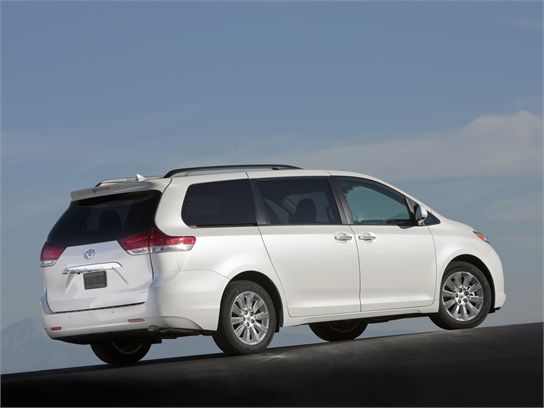
Nobody really wants to drive a minivan. They’re big and boring and they make you look like you’ve accepted a mundane suburban existence. The truth is, minivans are the best vehicle choice for families with more than a couple kids, especially if those kids participate in sports and extra-curricular activities. With the rise of SUVs and crossovers however, the minivan market has shrunk and some brands have gotten out of the game altogether. As a full-line automaker that offers something for everyone, Toyota has continued to offer a minivan, improving it with each new generation. The latest generation of the Toyota minivan, the Sienna, is making its debut as an early 2011 model. Now with optional four-cylinder power, a sporty SE model, and some unique comfort and convenience features, the Sienna offers everything a family needs, even if most people think it isn’t cool.
Page 2
The 2011 Toyota Sienna has a lot going for it. On the inside, it offers a comfortable environment for passengers, plenty of cargo space, and features and amenities that will keep the family happy, even on long trips. On the road, the ride is as smooth as ever, the V6 engine provides more than enough power, and the new four-cylinder is a capable and cheaper alternative. Plus, the Sienna is the only minivan offered with all-wheel drive. When you consider Toyota’s reputation for quality, reliability and proven resale values, the third-generation Sienna is a smart purchase for families on the go.
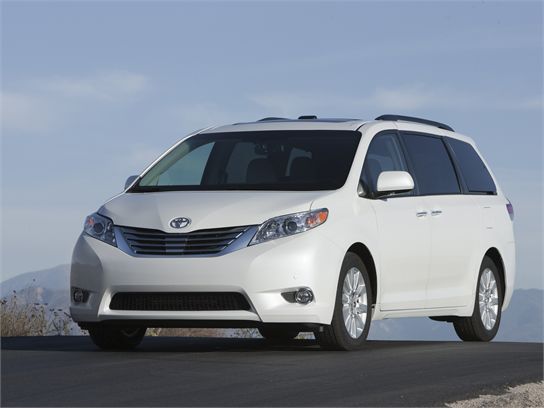
Page 3
The 2011 Toyota Sienna comes with a full list of standard safety features, plus some useful safety options. Passive safety equipment includes dual-stage front airbags, head-protecting curtain side airbags for the first and second seating rows, torso-protecting front side airbags, a driver’s knee airbag, active front head restraints, and Lower Anchors and Tethers for Children (LATCH) in the second-row captain’s chairs and the third row middle position. Active safety features consist of antilock brakes with brake assist and electronic brakeforce distribution, traction control, and electronic stability control. For those who want more security, Toyota offers front and rear park assist, hill-start control, rearview and 180-degree panorama cameras, and a Pre-Collision system that uses the available radar cruise control to predict collisions which readies braking pressure, retracts the front seatbelts, and will even intervene with emergency braking when a crash is unavoidable. Rustbelt buyers can also opt for the added traction of all-wheel drive.

Page 4
While the Sienna’s interior has taken a couple of steps forward with this generation, it has also taken a step back. The driver’s seating position has been adjusted to feel less upright and offer more rear travel so taller drivers will be comfortable. The 2011 model also adds a Multi-Information Display on top of the dashboard that shows such information as the time, temperature, climate and cruise control settings, and in models without a navigation system, the backup camera image. The bad news though, is Toyota’s choice of materials. While the dashboard is attractively designed and assembled with tight tolerances, it is largely made of thin, hollow plastics that make us worry about future squeaks and rattles. Even the door tops are hard plastic. Past Siennas had richer materials.
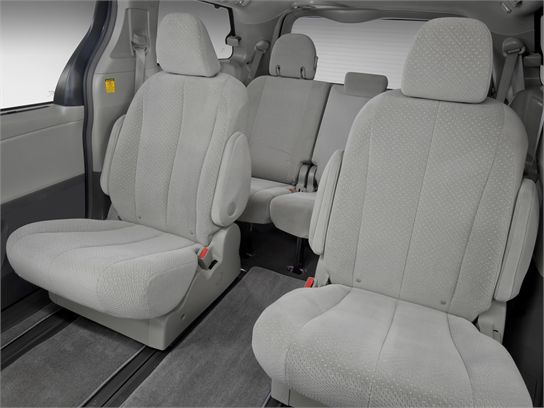
Page 5
Eight-passenger Siennas have a unique second-row center seat that can be detached and stored along the wall in the back of the van. While this small seat is less comfortable than others, it provides a handy walkthrough to the third row. Buyers looking for more comfort can opt for the available second-row lounge chairs with built-in footrests (standard on Limited). Thanks to tracks that allow the second-row seats to slide forward and back 23 inches, there is even enough room for an average size adult to recline. Finally, the DVD entertainment system comes with a unique 16.4-inch screen. It offers split screen capability, so kids watch different shows or play a game and watch a DVD at the same time. However in full screen mode, this screen provides a stretched, distorted image.
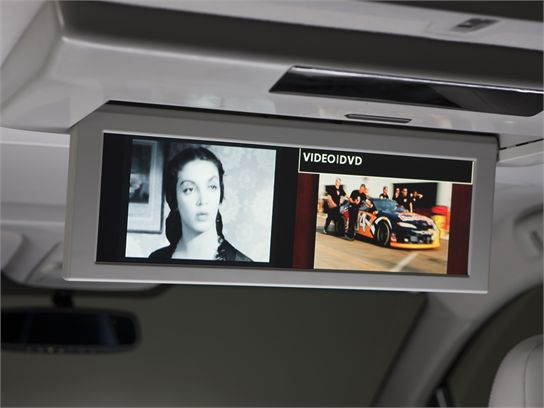
Page 6
The 2011 Toyota Sienna is offered in five models: base, LE, SE, XLE and Limited. The SE model is new, and it’s meant to be sportier than the others. The most notable changes are on the exterior, where it features a cool mesh grille, more aggressive front and rear fascias, side skirts that visually lower the vehicle, and attractive smoke-finish 19-inch wheels. Inside, there are leatherette seats with cloth inserts and a unique speedometer with a white background. To improve handling, the suspension uses stiffer shocks and springs, the stance is lowered 11 millimeters, and the electric power steering is tuned to be heavier and faster. From behind the wheel, the SE feels more planted than other models, with less body lean in turns and more responsive steering. The low-profile tires make more noise though, and the ride is notable firmer, so check it out before you buy.
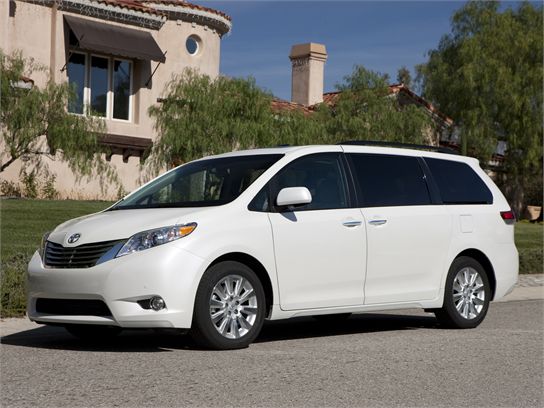
Page 7
Despite the sporty new model, the 2011 Toyota Sienna is still a big, heavy vehicle with a high center of gravity. A stripped down Sienna weighs 4275 pounds and an all-wheel drive model tops out at 4750 pounds before options. From behind the wheel, the heft means the Sienna leans a lot in turns, has numb steering feel, and doesn’t react quickly to fast changes of direction. We drove the Sienna on twisty California roads and could feel the weight shift from side to side, making us want to slow down. Those who want a more agile vehicle that still offers useful interior space should consider a station wagon or crossover. Many of today’s new breed of station wagons and crossovers are also fun to drive while providing plenty of interior room.
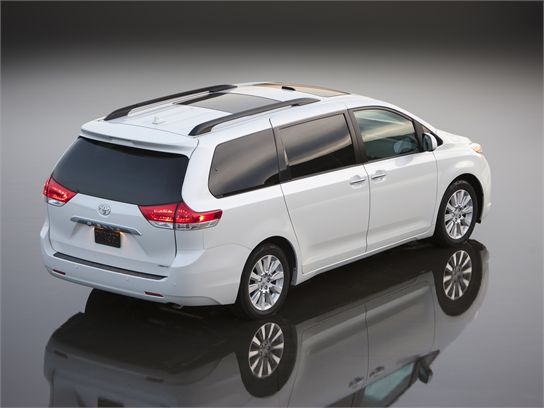
Page 8
The flip side to spongy handling is ride comfort. The Sienna derives its platform from the Toyota Camry, which rides as well as just about any luxury car on the market today. Though larger and heavier than the Camry, the Sienna also offers a very forgiving ride, thanks to its car-type architecture. Most models smooth out bumps with ease. The run-flat tires on all-wheel-drive models are a bit firm, but they don’t cause nearly as much pounding as the run-flats on the previous generation Sienna. Sound from either engine is well muffled in the cabin, and we detected no squeaks or rattles in several test vehicles. You can enjoy a smooth, quiet ride in the Sienna, if you can just keep the kids under control.

Page 9
A minivan needs space for passengers and cargo, and the Sienna is no exception. It offers seven- or eight-passenger seating configurations with plenty of cargo room to spare. With all the seats in place, there is still 39.1 cubic feet of rear cargo volume, thanks to a rear well that can swallow a full load of groceries, a flat big-screen TV, or several golf bags. The third-row seats fold into the floor to open up 87.1 cubic feet of space, and the Flip Up and Long-Slide second-row seats push forward (as much as 23 inches) to expand volume further. Finally, if you need to haul 4x8 sheets of plywood, the second-row seats can be removed entirely, with cargo space maxing out at 150 cubic feet.
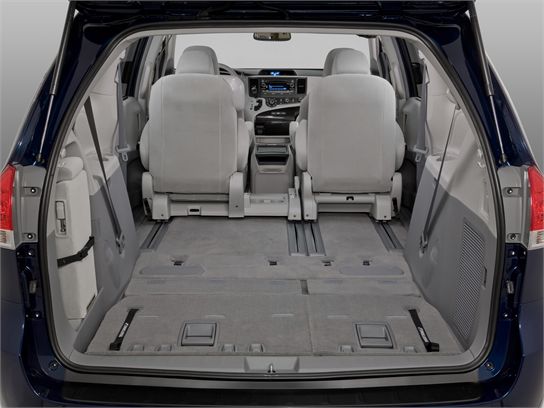
Page 10
In addition to the all-important seven- or eight-passenger seating, the 2011 Toyota Sienna has all the features you need in a minivan. Dual sliding side doors (available with power operation) make it easy for kids to get in and out. They also come with power windows that go down about three-quarters of the way, providing fresh air with a measure of security. An available power rear liftgate will allow you to seal up the van with your hands full. Thanks to a standard conversation mirror, you can watch the road while keeping your eye on the kids. Also, an optional DVD entertainment system will provide a measure of peace by keeping the kids occupied.
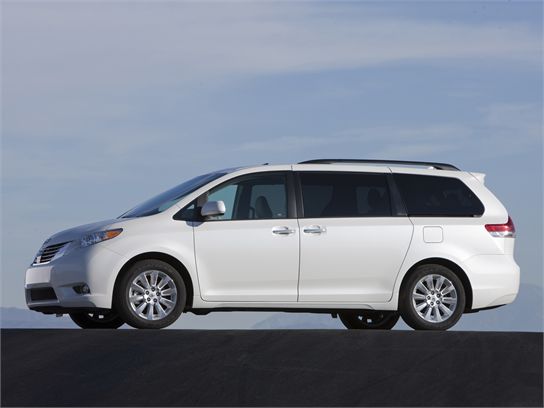
Page 11
In addition to the carryover 266-horsepower 3.5-liter V6, the 2011 Sienna adds a four-cylinder engine for the first time. The 2.7-liter four is the same engine that powers the Toyota Venza and Highlander. It is offered in the base and LE models, and it makes 187 horsepower and 186 pound-feet of torque, which is enough for most everyday needs. Power from a stop is more than adequate and drivers should have no problem keeping up with traffic. Compared to the V6, the four is notably rougher during hard acceleration and it just doesn’t have as much passing punch. However, it gets 19 mpg in the city and 26 mpg on the highway, compared to the V6’s 18/24 ratings, and it costs less, giving the 2011 Sienna a lower starting price than the 2010 model.
